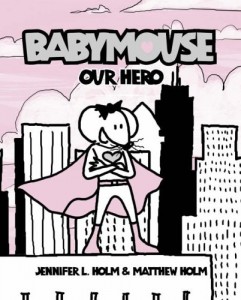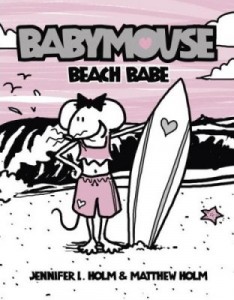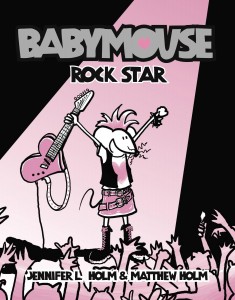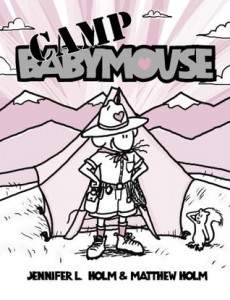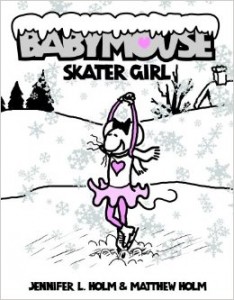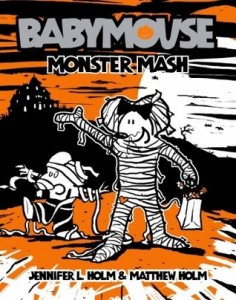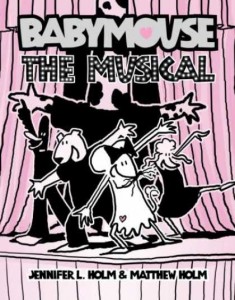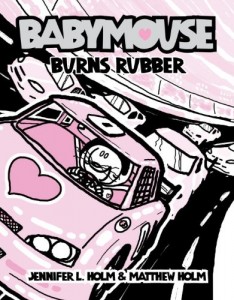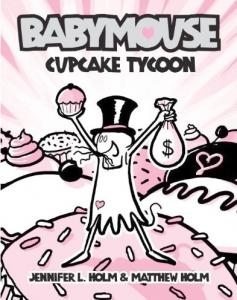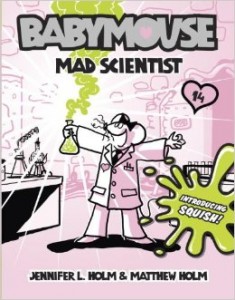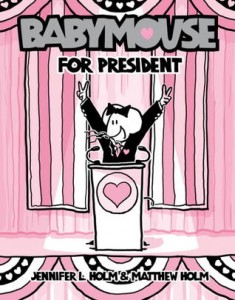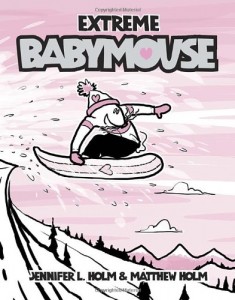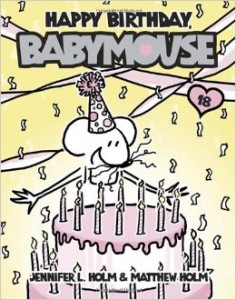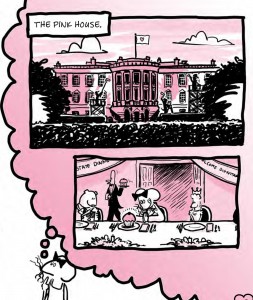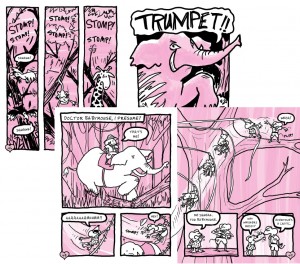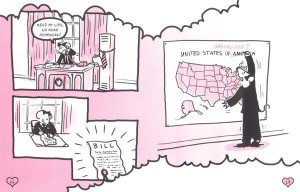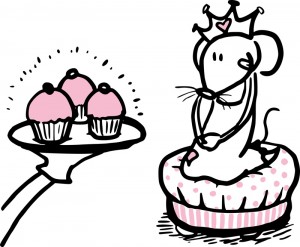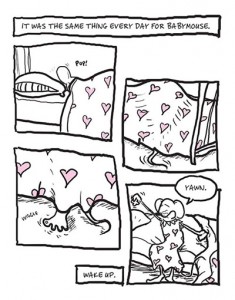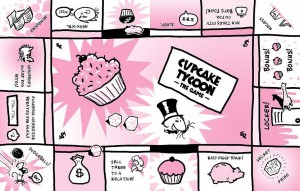Welcome to Using Graphic Novels in Education, an ongoing feature from CBLDF that is designed to allay confusion around the content of graphic novels and to help parents and teachers raise readers. In this column, we examine graphic novels, including those that have been targeted by censors, and provide teaching and discussion suggestions for the use of such books in classrooms.
This post takes a closer look at the Babymouse series by Jennifer Holm and Matthew Holm.
Babymouse is an award-winning graphic novel series that showcases the trials and tribulations of elementary school students and teachers, as seen through the eyes of Babymouse, as spunky, lovable mouse who wrestles with popularity, quirky lockers, competition — in the school band, school play, math Olympics, and even the best birthday party ever — and more. The series has won multiple Children’s Choice awards, the 2006 Gryphon Award, the 2006 ALA Notable Children’s Book Award, the 2006 New York Book Show Award,
The Babymouse series includes:
- Babymouse: Queen of the World
- Babymouse: Our Hero
- Babymouse: Beach Babe
- Babymouse: Rock Star
- Babymouse: Heartbreaker
- Babymouse: Camp Babymouse
- Babymouse: Skater Girl
- Babymouse: Puppy Love
- Babymouse: Monster Mash
- Babymouse: The Musical
- Babymouse: Dragonslayer
- Babymouse: Burns Rubber
- Babymouse: Cupcake Tycoon
- Babymouse: Mad Scientist
- A Very Babymouse Christmas
- Babymouse for President
- Extreme Babymouse
- Happy Birthday, Babymouse
Table of Contents
- OVERVIEW
- SUMMARY
- TEACHING/DISCUSSION SUGGESTIONS:
- COMMON CORE STATE STANDARDS (CCSS)
- LINKS AND RESOURCES
OVERVIEW
Babymouse is about a sassy young mouse who hates her curly messy whiskers, loves cupcakes, is an avid reader, seeks fame and adventure, and is constantly dreaming big — all while dealing with her nemesis, Felicia Furrypaws, and wresting with a locker that’s more like a magical black hole that sucks her into all kinds of worlds. Whether she’s off fighting dragons, becoming Queen of the World, or just planning for the best birthday ever, she’s a ton of fun.
Because she’s an avid reader and because she is constantly finding herself in some mess or challenge, Babymouse’s vivid imagination kicks in and helps her find the direction and courage to face her challenges head on. Her best friend Wilson the Weasel is always there to help her deal with school challenges and with those imposed by Felicia Furrypaws — the most popular kid in the school (who happens to have awesome, straight whiskers). Throughout the series, Babymouse, with the help of an equally sassy Narrator, weaves us through all that life might throw at someone, and through laughs, spills, and challenges, we root for Babymouse as she learns the meaning of true friendship.
Each book is full of references to classic books, movies and cultural innuendos. The Holms’ Babymouse is much like James Thurber’s Secret Life of Walter Mitty, but with a lot more spunk and attitude. These books are geared for 7- to 12-year-olds (with a publisher’s suggested reading level of Grade 2) and can be easily integrated into language arts and social studies lessons for grades 1-5. That said, they’re wonderfully entertaining for readers of all ages, and provide summer, school, or anytime fun.
SERIES SUMMARY
Babymouse: Queen of the World — It’s another year in school for Babymouse, and nothing seems to change. Everything’s boringly “typical.” That is until Babymouse finds out about Felicia Furrypaw’s exclusive slumber party, which everyone wants to be invited to. Babymouse must wrestle with whether she gets an invitation, and if she does get one, how she’ll tell her best friend Wilson that she can’t make their monster movie marathon.
Babymouse: Our Hero — Not only must Babymouse navigate good and evil: She has to face gym class. Even worse than gym class: She must deal with the annual dodge ball tournament. Wilson will help her practice, but will that be enough? Babymouse isn’t at all sure and must face her fears of injury, failure, and utter humiliation.
Babymouse: Beach Babe — School is out for the summer and Babymouse and her family are headed to the beach. The problem: Who is she going to hang out with? Definitely NOT her younger brother… or will she? In this volume, Babymouse faces the challenges of being a big sister, and the occasional fun it entails.
Babymouse: Rock Star — It’s school band time, and while Babymouse may have music in her soul, it’s “sadly not in her flute.” Luckily, Babymouse has a friend who helps her not only bring music from her soul into her flute, but may even help her unseat Felicia Furrypaws.
Babymouse: Heartbreaker — It’s Valentine’s Day! All in pink, what could be better (except maybe cupcakes)? In this volume, Babymouse wrestles with the very idea of romance and the school dance.
Babymouse: Camp Babymouse — Babymouse is off to camp for two weeks and is really looking forward to it. Until she has to deal with fears of facing and getting lost in the wilderness.
Babymouse: Skater Girl — As Babymouse sees that everyone around her has a talent, she feels a bit left out. Then she discovers the ice and surprises everyone with her spins and jumps. But when a famous Olympic coach, Coach Bearnakorva, discovers Babymouse, Babymouse must learn to balance her dreams and expectations with the reality around her.
Babymouse: Puppy Love — Babymouse loves animals but doesn’t have a great history with her pets. Even her goldfish ran away from home. In this volume, Babymouse wrestles with the idea of getting a dog — and whether she’ll ever find her missing fish!
Babymouse: Monster Mash — Babymouse’s imagination and creativity are put to the test this Halloween as she tries to come up with the best costume and Halloween party ever. But Felicia Furrypaws won’t take this lightly.
Babymouse: The Musical — A new (really cute) British boy, Henry Higgins, joins the school and urges Babymouse to try out of the play, even though it requires both singing AND dancing. He coaches Babymouse for the auditions and it’s anyone’s guess if Felicia Furrypaws will allow Babymouse to steal the show.
Babymouse: Dragonslayer — In order to pass math, Babymouse has to join the Fighting Fractions, the school math team for the math Olympics. They must battle the Owlgorithms and win back the Golden Slide Rule. As Babymouse tackles the Owlgorithms and her own personal dragon — MATH — she learns that there is more than one way to slay a dragon — or math word problem!
Babymouse: Burns Rubber — Babymouse and Wilson enter the Race of the Century, allowing them to fulfill Babymouse’s dream of becoming a racecar driver.
Babymouse: Cupcake Tycoon — After Babymouse inadvertently creates a flood in the school library, the librarian announces a fundraiser to help replace the damaged/lost books. The student to sell the most cupcakes wins a grand prize. They had Babymouse at “cupcakes.” In this volume, Babymouse learns all about the art of fundraising.
Babymouse: Mad Scientist — Babymouse, through the encouragement of her father and the help of his microscope, enters the school science fair. In this volume, Babymouse learns about the scientific method and the power of observation. As an added bonus, readers get to meet Squish for the first time. Squish is a paramecium kid that Babymouse observes and learns a lot from. Squish, in turn, learns all about cupcakes. It’s a win-win friendship, and the beginning of the Holms’ new series of books, Squish.
A Very Babymouse Christmas — With Christmas fast approaching, even though it’s the season for family, peace, and goodwill, Babymouse will do what she must to make sure she gets the present she wants. Even if it means out-smarting St. Nick himself.
Babymouse for President — Babymouse decides to run for school President… along with everyone else, even her locker! And, while a vote for Babymouse may mean a vote for cupcakes, Felicia Furrypaws is running a competitive campaign.
Extreme Babymouse — It’s winter and time for the Extreme Snowgames (at least in Babymouse’s fantasies). Babymouse wants to head for the slopes for the weekend with EVERYBODY else. And while enthusiastic, she doesn’t exactly have a great history with being outdoors. In this installment, she’s hoping to make it off the bunny slope!
Happy Birthday Babymouse — Babymouse’s birthday is fast approaching and this year she plans to have the most awesome party ever (especially because her other birthdays didn’t quite pan out the way she had hoped). She sends invitations to everyone and starts shopping around for entertainment and cupcakes, only to find that Felicia Furrypaws has already invited everyone to her party — same time, same day.
In short Babymouse is a series of stories about a spunky, imaginative, ambitious young mouse who faces her life’s challenges with all she can muster. Whether she’s facing off with her nemesis Felicia Furrypaws or dealing with school pressures, Babymouse learns to lean on her friends, her imaginative solutions (based mostly on the books she reads), and the occasional help of her family. Throughout each challenge, Babymouse always faces her challenges with puns, metaphors, loads of literary, historical, and cultural references and humor and humility.
Throughout the series, Babymouse:
- Learns about the power (and responsibilities) of friendship and frenemies;
- Learns how to accept fate while facing and navigating fears;
- Recognizes the responsibilities of being an older sibling while discovering the fun it can entail;
- Learns that practice alone doesn’t make perfect, but putting your heart into it will definitely help;
- Learns to recognize and accept what she’s good at and not so good at while balancing dreams and expectations;
- Learns that sometimes, when you’re weak in one area, you can use your strengths and skills to help you succeed;
- Learns all about economics, public relations, and how to outsell even Felicia Furrypaws and raise money in the school library fundraiser;
- Learns the power of observation and scientific method;
- Learns what it takes to be a hero
Babymouse themes include:
- The power and importance of friendship;
- Facing and overcoming fears with the help of friends, family, and creative thinking;
- The gift of giving is more powerful than that of receiving;
- Working hard and while facing fears and building strengths will help win competitions;
- The power of unexpected gifts;
- The importance and empowerment of loyalty;
- When social changes are needed, get involved;
TEACHING/DISCUSSION SUGGESTIONS:
Plot, Themes, and Values Related
- Chart and discuss how each Babymouse book has a theme and uses classic literary works to help express and reinforce the theme. You may want to break the class into groups, and give each a book to analyze, discuss, and present.
- In each volume, Babymouse must overcome some challenge. Plot the different challenges and Babymouse’s strategies for facing them.
- Over the course of the series, discuss whether Babymouse has changed or not. Have students bring in evidence to support their positions.
- Compare and contrast how the characters and their friendships have developed and changed throughout the series. Discuss different types of friendships one might have with others. Detail what it means to be a good friend. Discuss the challenges we have in determining and maintaining friendships and why this is so important.
Critical Reading and Making Inferences
- Search and discuss the many wisdoms and truths Babymouse learns in each book. Discuss how wise or somewhat misgiven they may be and why. For example:
- In Babymouse: Our Hero, Babymouse learns that, “A coward dies a thousand deaths but a hero dies but one” (p. 88).
- In Babymouse: Dragonslayer, Babymouse learns, “Don’t be discouraged, just because you’re not good at something it doesn’t mean you have to be terrible at it either” (p. 37).
- In Babymouse: Dragonslayer, Babymouse learns, “When you believe in something…it’s worth fighting for” (p. 52).
- In Babymouse: Cupcake Tycoon, Babymouse is frustrated because there are too many kids in her neighborhood who already went to neighbors asking them to buy their cupcakes. Brainstorm (much as Babymouse does) different ways to try to sell cupcakes.
- Search for and chart literary references made in each of the Babymouse books. Some are obvious references while others can be inferred. You may want to divide the class into groups and give each group a different Babymouse book. Have them read the books, find literary references, and present how those references helped Babymouse better understand and face her challenges. For example:
- In Babymouse: Queen of the World, there are references to Cinderella, The Wild, Wild, West, Alice in Wonderland, and Frankenstein.
- In Babymouse: Beach Babe, there are references to The Little Mermaid, Aladdin, and the Stanley and Livingston expedition through Africa
- In Babymouse: Rock Star, there are references to The Wizard of Oz and The Pied Piper of Hamelin.
- In Babymouse: The Musical, there are references to classic plays including My Fair Lady, Phantom of the Opera (although here, it’s “Phantom of the Locker”), The Lion King, Grease, and Annie.
- In Babymouse: Dragonslayer, there are references to The Lion, The Witch and the Wardrobe, Lord of the Rings, and Harry Potter.
- The Babymouse series is all about navigating the challenges of elementary school. Have students (in groups, pairs or individually) chart social skills and lessons Babymouse learns.
Language, Literature, and Language Usage
- Search/chart and discuss literary devices used in Babymouse (particularly onomatopoeia, puns, metaphors, and idioms). You may want to compare other ways to relay the same idea in an effort to show the value of these devices.
- As Babymouse has a vivid imagination, she tends to exaggerate. Discuss the use of hyperbole throughout the series and how it helps relay Babymouse’s character.
- Puns and idioms are rife in these books, from slaying dragons (Babymouse: Dragonslayer) to “being in the trenches” (pp. 82-83, Babymouse: Our Hero), to how Babymouse “certainly brought down the house” (p. 87, Babymouse: The Musical), to having hopes and dreams shattered (Happy Birthday, Babymouse), and more. Search, define, and discuss these literary devices and have the class brainstorm others.
- Metaphor — Babymouse: Dragonslayeris all about metaphor. Define metaphor for the class and discuss how the image of Babymouse slaying the (math) dragon helps tell the story and help the reader understand how Babymouse overcame her fear of math. You may want to brainstorm and discuss other uses of metaphor throughout the series.
- Hyperbole — Have students (individually, in pairs or in groups) create an event in which there are dire consequences. Then have them write two outcomes, one realistic and one greatly exaggerated (hyperbolic). Have them share their examples and discuss when they might use one over the other and why.
- Foreshadowing — In many of the books the Narrator or even Babymouse (when expressing her fears) foreshadows what is to come. Search for uses and examples of foreshadowing and discuss how this affects the readers’ reactions and expectations.
- In many of the books, there are newspaper articles relating important news in Babymouse’s life. For example, in Babymouse: Rock Star (p. 20), there is a newspaper article in Mouse News about how “Penny Poodle Dies of Embarrassment!” You may want to discuss the language use and power of headlines and bylines versus the language used in the body of a news article. Then have students create their own news articles and headlines.
- In Babymouse: The Musical, the book is written in acts and therefore structured differently, more like a play. Discuss the different format used here and how it affects the story.
Modes of Storytelling and Visual Literacy
In graphic novels, images are used to relay messages with and without accompanying text, adding additional dimension to the story. In Babymouse,Jennifer and Matthew Holm weave the story, emotions, and insights through the use of text, image, and design. For example:
- Analyze and discuss how Jennifer and Matthew Holm verbally and visually separate the Narrator from Babymouse, and how they separate Babymouse’s daydreams from reality.
- Analyze and discuss how the authors use shades of pink, white, and black to relay different elements of the story.
- Chart, analyze, and discuss how balloon shapes and font styles and sizes are used to relay information.
- On the cover page of Babymouse: Dragonslayer, there is a coat of arms. Discuss why these images may have been included in Babymouse’s family coat of arms. Have students create their own family coat of arms. You may want them to write about why those elements were selected, and then have them present their work to the class.
- In Babymouse: Dragonslayer on page 28 there are some posters that play with language and math (“Divide and Conquer…” and “Athletes Exercise Their Brains”). Using concepts of math and verbal and visual literacy, have students create their own “punny” math posters.
- In Babymouse For President, Felicia, Santiago, Georgie, and Babymouse have posters with art and slogans to try to convince students to vote for them. First, have students analyze and discuss which posters are their favorite and why. Then have students design their own slogans and posters.
Content –Area Lessons:
- Math: Babymouse: Dragonslayer, is all about a math Olympics. You may want to:
- Create your own math Olympics. You may even want your students to help discuss the different events and even create their own math problems for those events.
- Have students create math posters (much like on page 28) that integrate math concepts with puns and play on words.
- Throughout this volume, there are many math references (for example: fractions and parabolic curves). Have students seek, find, and define these references.
- Babymouse’s fear of math stems from her difficulty with fractions. She finds, however, that there are some math problems with different means of solutions. For example, on p. 86, she uses her understanding of maps and words to chart a solution to a word problem. Discuss and evaluate this strategy.
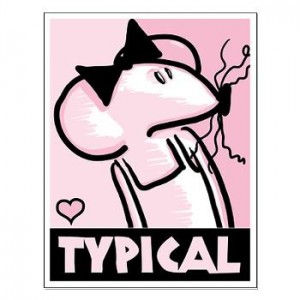 Math: Babymouse: Cupcake Tycoon is all about fundraising. Have students brainstorm and come up with a fundraising goal and a fundraising activity (selling cupcakes, cleaning cars, etc.). Determine the base amount needed for the goal, discuss fundraising strategies, calculate averages, means, and percentages.
Math: Babymouse: Cupcake Tycoon is all about fundraising. Have students brainstorm and come up with a fundraising goal and a fundraising activity (selling cupcakes, cleaning cars, etc.). Determine the base amount needed for the goal, discuss fundraising strategies, calculate averages, means, and percentages.- History: In Babymouse: Our Hero, Babymouse misses the bus and has to walk to school. As she fears she’ll never make it, she thinks of the difficult trek America’s settlers made through the West, where, “The trail was long and dusty… But they were searching for a better life… Hardship was to be expected…”(pp. 21-23). You may want to use this as a jumping off point for discussing the difficulties early American settlers faced, comparing their journeys to modern day journeys that may be equally challenging.
- History/Social Studies: Babymouse For President is all about our electoral process and is full of references to past U.S. Presidents, speeches, and political events. You might use this book for discuss the following in greater detail:
- On page 31, we see one of the founding fathers, “We hold these truths to be self-evident that all men are created equal.” Discuss the reference and its historical/cultural significance.
- On pages 56-59, the authors make reference to Tammany Hall and politicians’ use of promises. Discuss the historical reference and whether we are better off today in local/national/international politics.
- On page 65, Babymouse is asked, “What qualities make you a good candidate?” Brainstorm, discuss, and debate this question with your students.
- Throughout the book there are references to past presidents and their memorials. Have students search for these references in this volume and then research their histories/contributions.
- History/Geography/Math: Babymouse: Dragonslayerbegins with Babymouse deep in fantasy with a map of a “Distant Kingdom” as she is about to face a dragon. There are a number of lesson paths you can take with this:
- Discuss the names on the map (Meatloaf Mountains, Caer Cupcake, Loch Locker, etc.). Discuss why the authors chose the words “caer” and “loch.”
- This is a great bridge to teaching students how to read and make maps (involving both geography and math). Have students create their own maps of the school, classroom, of their paths from home to school, “treasure maps” in the school playground, etc.
- Using maps students created, or maps you have on file, have students “follow” the maps. Discuss how accurately they led you to the desired destination.
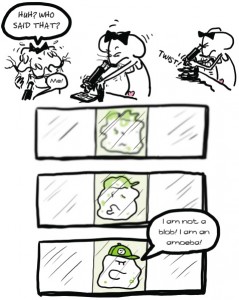 History/Science: In Babymouse: Beach Babe (pp. 45-49), as Babymouse and her family are on the way to the beach, the drive is unbearably long and Babymouse is told to amuse herself. And without hesitation, she finds herself exploring deep in the heart of Africa as “Doctor Babymouse,” a spoof on Livingston and Stanley. Use this reference to teach about the scientific and historical significance of their explorations.
History/Science: In Babymouse: Beach Babe (pp. 45-49), as Babymouse and her family are on the way to the beach, the drive is unbearably long and Babymouse is told to amuse herself. And without hesitation, she finds herself exploring deep in the heart of Africa as “Doctor Babymouse,” a spoof on Livingston and Stanley. Use this reference to teach about the scientific and historical significance of their explorations.- History/Science: In Babymouse: Mad Scientist, the authors reference a number of famous scientists, including Sir Isaac Newton, Galileo Galilee, Marie Curie, Albert Einstein, Ben Franklin, and Jonas Salk. Divide students into groups, and have them research the lives and contributions these scientists made and present their findings to the class.
- History/Science: In Babymouse: Mad Scientist, the authors introduce a new character Squish a single-celled amoeba. Have students chart the facts and fictions about amoebas as presented in this book.
Suggested Prose Novel and Poetry Pairings
For greater discussion on literary style and/or content, here are some prose novels about growing up, about being a pre-teen, and about challenges of middle school and high school that you may want to read and pair with Babymouse:
- The Secret Life of Walter Mitty by James Thurber — a short story about Walter Mitty a quiet man with a very vivid imagination, much like Babymouse’s.
- Alice’s Adventures in Wonderland by Lewis Carroll — a story of a girl’s vivid imagination as she falls down a rabbit hole into a fantasy world with anthropomorphic characters.
- Turtle in Paradise by Jennifer Holm — a Newbery Honor Book that blends family lore with America’s past in a charming novel rich in detail and humor
- The Fourteenth Goldfish by Jennifer Holm — about an eleven-year old girl named Ellie, her fourteen goldfish, and her Grandpa Melvin. Compare the writing style of Ms. Holm’s prose and graphic novels. Discuss the similarities and differences in her language use and structure.
- Squish by Jennifer and Matthew Holm — another graphic novel series by this awesome duo. Compare and contrast their use of language, page design, and themes in each series.
- Diary of a Wimpy Kid by Jeff Kinney — a series about a boy and his struggles in middle school.
- Amelia Rules! by Jimmy Gowned — a series about a group of friends and how they navigate the challenges of life, divorce, friendships, good versus evil, and of course, school.
COMMON CORE STATE STANDARDS (CCSS)
While this book is written for young readers (with a Grade 2 reading level), and suggested for elementary school classrooms it can be incorporated into language arts and content-area classes for a variety of grades. I therefore will be using the Common Core Anchor Standards for College and Career Readiness for Reading, Writing, and Speaking and Listening. Reading Babymouse and incorporating the teaching suggestions above promotes critical thinking and its graphic novel format provides verbal and visual story telling across subject areas while addressing multi-modal teaching. Here’s a more detailed look:
- Knowledge of Language: Apply knowledge of language to understand how language functions in different contexts, to make effective choices for meaning or style, to comprehend more fully when reading or listening.
- Vocabulary Acquisition and Use: Determine or clarify the meaning of unknown and multiple-meaning words and phrases by using context clues, analyzing meaningful word parts, and consulting general and specialized reference materials; demonstrate understanding of figurative language, word relationships, and nuances in word meaning; acquire and use accurately a range of general academic and domain-specific words and phrases sufficient for reading, writing, speaking and listening at the college and career readiness level.
- Key ideas and details: Reading closely to determine what the texts says explicitly and making logical inferences from it; citing specific textual evidence when writing or speaking to support conclusions drawn from the text; determining central ideas or themes and analyzing their development; summarizing the key supporting details and ideas; analyzing how and why individuals, events, or ideas develop and interact over the course of the text.
- Craft and structure: Interpreting words and phrases as they are used in a text, including determining technical, connotative, and figurative meanings and analyzing how specific word choices shape meaning or tone; analyzing the structure of texts, including how specific sentences, paragraphs and larger portions of the text relate to each other and the whole; Assessing how point of view or purpose shapes the content and style of a text.
- Integration of knowledge and ideas: Integrate and evaluate content presented in diverse media and formats, including visually…as well as in words; delineate and evaluate the argument and specific claims in a text, including the validity of the reasoning as well as the relevance and sufficiency of the evidence; analyze how two or more texts address similar themes or topics in order to build knowledge or to compare the approaches the authors take
- Range of reading and level of text complexity: Read and comprehend complex literary and informational texts independently and proficiently
- Comprehension and collaboration: Prepare for and participate effectively in a range of conversations and collaborations with diverse partners, building on others’ ideas and expressing their own clearly and persuasively; integrate and evaluate information presented in diverse media and formats, including visually, quantitatively and orally; evaluate a speaker’s point of view, reasoning, and use of evidence and rhetoric.
ADDITIONAL RESOURCES:
- http://www.randomhouse.com/kids/babymouse/ — with links about the books, games, printable posters, “Babymouse: The Musical” (a song you can download), ecards you can send to a friend, “Build-Your-Own Babymouse Adventure,” and a link about the world of graphic novels.
Meryl Jaffe, PhD teaches visual literacy and critical reading at Johns Hopkins University Center for Talented Youth OnLine Division and is the author of Raising a Reader! and Using Content-Area Graphic Texts for Learning. She used to encourage the “classics” to the exclusion comics, but with her kids’ intervention, Meryl has become an avid graphic novel fan. She now incorporates them in her work, believing that the educational process must reflect the imagination and intellectual flexibility it hopes to nurture. In this monthly feature, Meryl and CBLDF hope to empower educators and encourage an ongoing dialogue promoting kids’ right to read while utilizing the rich educational opportunities graphic novels have to offer. Please continue the dialogue with your own comments, teaching, reading, or discussion ideas at meryl.jaffe@cbldf.org and please visit Dr. Jaffe at http://www.departingthe text.blogspot.com.
All images (c) Jennifer L. Holm and Matthew Holm.

